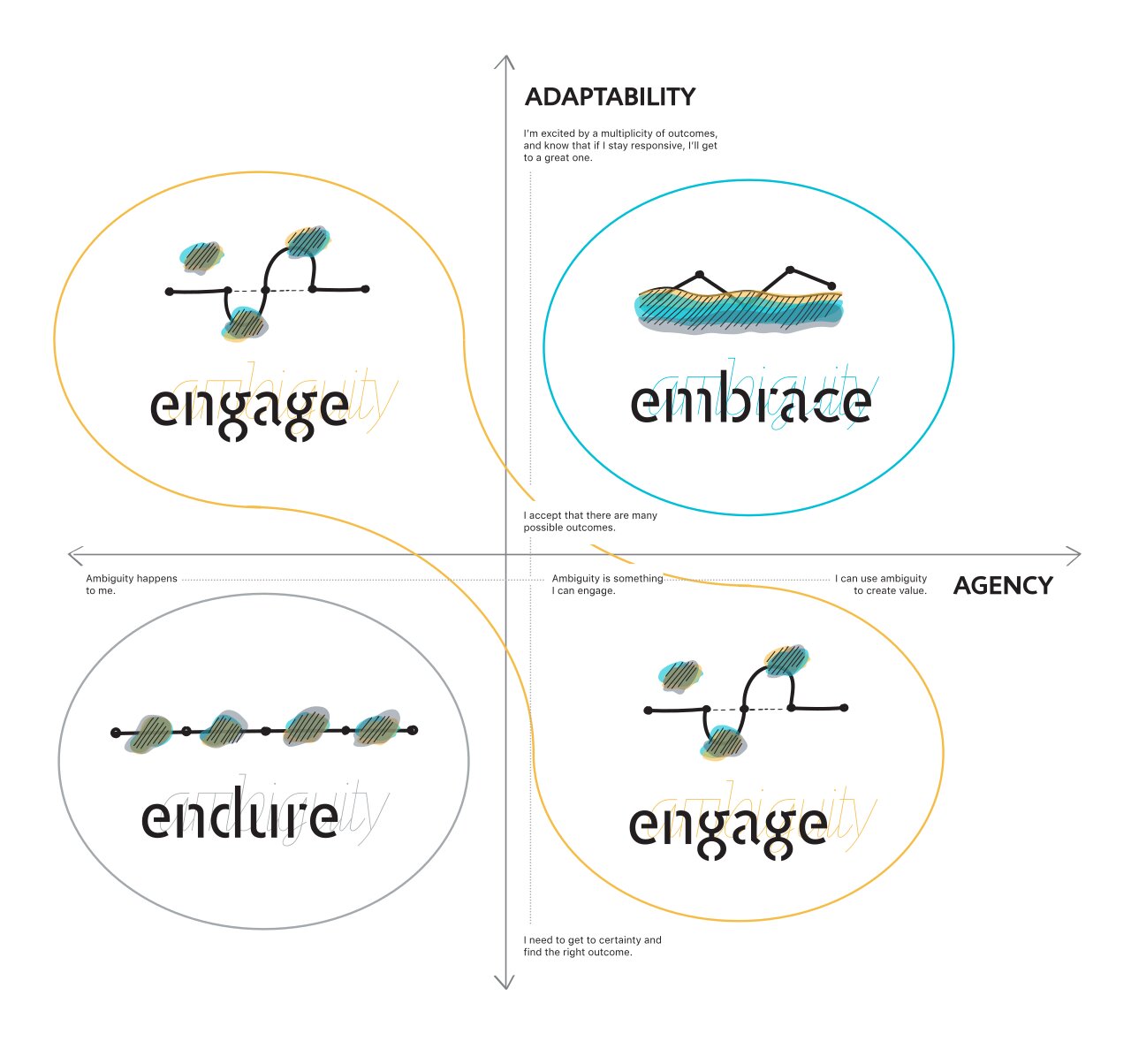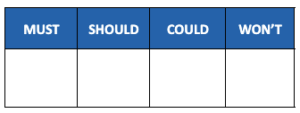Rachel Nozari | July 2022
As a society, we’ve experienced immense ambiguity in the last two-plus years. We lived through a global pandemic and managed day in and day out uncertainty with fast-changing needs to respond to. We grappled with personal and family health concerns, sustained disruption to schooling and childcare, “the great resignation”, and likely a general feeling of being overloaded and overwhelmed.
Ambiguity Metaphor
Before we dive in, join me in a brief activity; you’ll need a pen and a piece of paper.
Bring to mind a time, maybe over the last couple of years, when you experienced a lot of ambiguity. To the extent you feel comfortable, try to put yourself back in that moment.
- What was happening in your life?
- How were you feeling in your body?
- What kinds of things were you thinking?
Now fill in the blanks in the following sentence:
“Ambiguity is like ____________, because ________________.”
This is your ambiguity metaphor1. Hang on to this, we’ll come back to it.
Ambiguity, It’s Here to Stay
Ambiguity is a general sense of uncertainty, of experiencing the unknown. For many people ambiguity brings up feelings of stress and anxiety, which in turn negatively impacts their creativity, motivation, engagement, and fulfillment at work. Over time, this kind of sustained stress can result in loss of self-efficacy, cynicism, and ultimately burnout.
But the thing is, ambiguity is not going to go away. While hopefully, we will not experience another global pandemic in our lifetime, research shows the landscape we live and work in is changing at a much faster pace than it used to, largely driven by technological advancements and increasing globalization2. The fact of the matter is, that our relationship with ambiguity has and will continue to have a big impact on our day-to-day experience, overall wellbeing, and engagement in the workplace; as well as that of the teams we lead.
Which raises the question, as team and organizational leaders, how can we support our folks to navigate ambiguity without burning out?
Strategies and Frameworks to Navigate Ambiguity
Here are some strategies that might help you to better understand your own (and your teammate’s) orientation to ambiguity and navigate that uncertainty with improved sustainability.
1. Understand your own relationship with ambiguity. As a leader, it’s important to be aware of your own biases, how you respond under stress, and the impact that can have on your work and those around you. In 2018 the Stanford d.School used the ambiguity metaphor activity with 150 incoming and outgoing students3. They found two important things,
-
- First, the ambiguity metaphor can tell you a lot about each person’s relationship with ambiguity, which is typically linked to their personal sense of agency and ease of adaptability. People generally fall into one of three categories:
- Those who endure ambiguity, see it as something to get through, something that is happening to them, something fairly negative.
- Those who engage ambiguity, see it as something they can choose to stay with, something to actively navigate.
- And those who embrace ambiguity, see it as an opportunity, are excited by the potential of the unknown4.
- First, the ambiguity metaphor can tell you a lot about each person’s relationship with ambiguity, which is typically linked to their personal sense of agency and ease of adaptability. People generally fall into one of three categories:
When you look back at your ambiguity metaphor, which category do you fall into?

- The second important thing the Stanford d. School learned through this activity, is that people’s relationship with ambiguity can change and improve over time the more exposure they have to it.
2. Understand your team members’ and colleagues’ relationship with ambiguity. Equally important as being self-aware of your own relationship with ambiguity as a leader, is understanding the relationship of those around you. You don’t necessarily want your whole team to be super comfortable with ambiguity, for example, there are very real reasons why you might want your legal/risk/finance folks to be less comfortable. Understanding each person’s orientation can increase empathy for their experience and allow you to help them endure, engage or embrace ambiguity in a way that is sustainable.
- Find purpose. When folks understand what they’re driving towards and why it’s important, they feel more anchored to something meaningful even during day-to-day ambiguity. Research conducted during the pandemic finds those who say they are “living their purpose” at work are five times more likely to have a positive sense of well-being, and four times more likely to have higher engagement levels. With this clarity, they are also more easily able to exercise agency, make decisions, recover from negative events, and navigate (maybe even embrace) ambiguity5.
Ask yourself (and your teammates):
- What do you do? (What do you do? Everyone does their role differently and we know folks often serve in multiple capacities, what do you actually do?)
- Why is that important to others, or to the world?
- Why is it important to you personally?
Complete the sentence:
I do _____________, so that __________. This matters to me because _______________.
- Increase clarity by working in shorter cycles, and prioritize, prioritize, and reprioritize. Set direction (connected to your purpose) and near-term goals in shorter cycles so you can check in on progress, assess what’s working and what’s not working, and adjust course more effectively. This will require you to practice that important skill of adaptability which helps us get more comfortable with ambiguity. It will also require you and your team members to build the ever-important skill of prioritization. Prioritizing work in short cycles helps people find the level of short-term clarity they need to move forward with an increased sense of agency. This practice will help teams prioritize and pursue meaningful work, and it will help build the skills needed to do this independently over time.
Here are a couple of quick tools that can help teams and individuals prioritize work:
Eisenhower Matrix
The Eisenhower Matrix is used to support individuals/teams to make difficult prioritization decisions by determining what will make them most impactful based on relative urgency and importance, not just most productive.

MoSCoW Method
The MoSCoW Method supports individuals/teams to make difficult prioritization decisions by increasing clarity and alignment about what should be prioritized (must and should be done/included) and deprioritized (could if time, and explicitly will not be done/included).

Whether you thrive in ambiguity or prefer clarity and certainty, there are two things we can be sure of:
- We all have the potential to improve our relationship with ambiguity
- In this rapidly changing world, ambiguity isn’t going anywhere
We want to hear from you: How are you navigating ambiguity in your organization, and what are you learning along the way? Connect with us on Twitter, Instagram, Facebook, or LinkedIn to continue the conversation!
References
- Hasso Plattner Institute of Design at Stanford University. (2019). Ambiguity metaphor exploration worksheet: How do students personally relate to ambiguity? And how does that change with time?. https://dlibrary.stanford.edu/ambiguity/ambiguity-metaphor-exploration-worksheet
- Golman, D. (2011). What Makes a Leader?. In HBR’s 10 Must Reads: Leadership (pp. 1-21). Harvard Business School Publishing Corporation. (Original work published 2004)
- Hasso Plattner Institute of Design at Stanford University. (2019). Ambiguity metaphor exploration worksheet. https://dlibrary.stanford.edu/ambiguity/ambiguity-metaphor-exploration-worksheet
- Hasso Plattner Institute of Design at Stanford University. (2019). Ambiguity archetypes. https://dlibrary.stanford.edu/ambiguity-archetypes
- Dhingra, N., Emmett, J., Samo, A., & Schaninger, B. (2020). Igniting individual purpose in times of crisis. McKinsey Quarterly. https://www.mckinsey.com/business-functions/people-and-organizational-performance/our-insights/igniting-individual-purpose-in-times-of-crisis
- Indeed Editorial Team. (2021). How to be more productive using the eisenhower matrix. https://www.indeed.com/career-advice/career-development/eisenhower-matri
